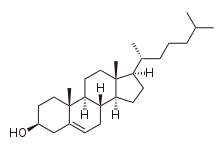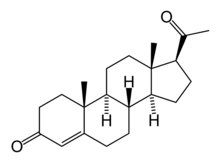Structural Biochemistry/Lipids/Cholesterol

Cholesterol is a lipid with a unique structure consisting of four linked hydrocarbon rings forming the bulky steroid structure. There is a hydrocarbon tail linked to one end of the steroid and a hydroxyl group linked to the other end. The hydroxyl group is able to form hydrogen bonds with the nearby carbonyl oxygen of phospholipid and sphingolipid head groups. Cholesterol is known as a "sterol" because it is made out of alcohol and steroid. Cholesterol is present in most animal membranes with varying amounts but is absent in prokaryotes and intracellular membranes.
Cholesterol is also a key regulator of membrane fluidity in animals. It is able to insert itself into bilayers perpendicular to the membrane plane. The hydroxyl group forms hydrogen bonds with the carbonyl oxygen of a phospholipid head group while the hydrocarbon tail positions itself in the non-polar core of the bilayer. Since the structure of cholesterol differs from phospholipids, it disrupts the normal reactions between fatty acid chains. Cholesterol is also able to form lipid rafts when it forms specific complexes with certain phospholipids, which results in membranes that are less fluid and less subject to phase transitions. This also increases the permeability of the cell membrane to hydrogen and sodium ions.
Cholesterol is usually synthesized in animals and smaller cholesterol can be generated in plants. They are important in the composition of cell membranes and also steroid hormones.
The human liver makes 100% of the cholesterol needed for our body. There is no need to eat another animal to obtain any cholesterol. As the Institutes of Medicine of the National Academies has stated, "All tissues are capable of synthesizing enough cholesterol to meet their metabolic and structural needs. Consequently, there is no evidence for a biological requirement for dietary cholesterol." (Dietary DRI Reference Intakes. The Essential Guide to Nutrient Requirements. Institute of Medicine of the National Academies. The National Academies Press, Washington, DC.)
That statement highlights that the human body can eat a whole food plant-based diet (WFPB) and still make 100% of the cholesterol needed for the structural integrity of all its cells.









Cholesterol has played an important role in every cell in our body, especially abundant on the cell membrane, which functions as a communicator with other cells in our body. Small amount of cholesterol can also be found on the membrane of some organelles inside the cells, such as the mitochondrion and the endoplasmic reticulum.
Cholesterol is referred to as an amphipathic molecule, that it contains its hydrophilic and hydrophobic parts. The hydroxyl group (-OH) in cholesterol is aligned with the phosphate head of the phospholipid on the cell membrane, which the rest of the cholesterol goes with the fatty acid of the membrane. It is very important that cholesterol is present on all the cell membrane due to its properties keep the cell firm and avoid being overly fluid.
Another effect that cholesterol has in our body is that it promotes our learning ability and memory. It plays an important role in our nervous system. Good sleep can enhance learning ability and memory formation, and at the same time, a study showed that cholesterol synthesis increases during sleep. Not only cholesterol is abundant on the cell membranes, and also abundant in brain tissue in the nervous system. An important nerve cell, Myelin, covers nerve axons to help conduct the electrical impulses that make movement, sensation, thinking, learning, and remembering possible. The study showed that cholesterol was found to be the most important factor in the formation of synapses, which is greatly affecting our memory and learning ability.
Functions of Cholesterol[edit | edit source]
Cholesterol serves a variety of functions in the human body. This includes:
-The manufacture of steroids, or cortisone-like hormones, including vitamin D and the sex hormones testosterone, estrogen and cortisone. This in turn controls a myriad of bodily functions.
-Assisting the liver in the manufacture of bile acids, which is essential for digestion and absorption of fat-soluble vitamins such as vitamin A, D, E and K.
-Formation of the myelin sheath, a neuron consisting of fat-containing cells that insulate the axon from electrical activity. This ensures proper function of our brains by aiding route of electrical impulses. The absence of cholesterol might lead to loss of memory and difficulty in focusing.
-As a cell to interconnect "lipid molecules", which are needed to stabilize our cell membranes.
-As a source of energy
-Maintenance of our body temperature
-Protection of internal organs
- Modulation the fluidity of cell membranes
Health Significance[edit | edit source]
Cholesterol and triglycerides cannot dissolve in the blood. They have to be transported within the cells by carriers called lipoproteins. Low-density lipoprotein( LDL) and very low-density lipoprotein (VLDL) are known as the "bad" cholesterols while high-density lipoprotein (HDL) is known as "good" cholesterol.
Cholesterol Metabolism 1. LDL binds to a specific receptor, the LDL receptor (integral membrane protein) 2. Segment of the plasma membrane containing the LDL-LDL-receptor complex then invaginates and buds off from the membrane to form an internal vesicle. 3. The LDL separates from the receptor and is recycled back to the membrane in a separate vesicle. Vesicle containing LDL fuses with a lysosome leading to the degradation of the LDL and the release of cholesterol. This process can be beneficial because hormones and antibodies can transport proteins use this method. However, on the downside the pathway is also available to viruses and toxins as a means of entry into the cell.
During circulation, VLDL is converted in the bloodstream into LDL.
Hypercholesterolemia is a condition when there is an extremely high level of cholesterol in the body. Usually this means that there is a high concentration of LDL and low concentration of HDL. When too much LDL circulates the blood cell, it can build up on the inner walls of arteries that feed the heart and brain, and therefore, cause the clogging of the arteries. The health significance is that they are prone to cardiovascular diseases. If a clot forms and blocks the narrowed artery, a series of cardiovascular diseases such as hypertension, myocardial infarction, arteriosclerosis, angina pectoris, heart attack or stroke can result. High levels of cholesterol are also closely associated to diabetes.
HDL is known as "good" cholesterol in that it removes excess cholesterol in the arteries and transport it back to the liver for excretion or re-utilization, and thus preventing the arteries from clogging.
Hypocholesterolemia is a condition when there is an extremely low level of cholesterol in the body. This condition is usually rare, but if they do occur, it might be because of other illness that has caused the body to generate low or no cholesterols.
LDL cholesterol can be calculated with a rather rapid test based on the Friedewald equation, in which:
Total cholesterol = LDL cholesterol + HDL cholesterol + VLDL cholesterol
where VLDL cholesterol = triglycerides/5
One can rapidly and easily do a lipid profile by enzymatically measuring the important lipids—-total cholesterol, HDL cholesterol, and triglycerides. Dividing triglycerides by five gives the relatively unimportant, but hard to measure, VLDL cholesterol, which can in turn be used to calculate the important LDL cholesterol.
It should be noted that the equation does have certain limitations, and should not be used under circumstances:
•When chylomicrons are present.
•When triglyceride level exceeds 250.
•In patients with dysbetalipoproteinemia (type III hyperlipoproteinemia).
•Within about 12 hours after a meal, because triglyceride level can shoot up 20-30%
•Within 24 hours after the consumption of alcohol
Important numbers to know
| Desirable level | |||
|---|---|---|---|
| Total cholesterol | under 200 mg/dL | ||
| LDL, the bad cholesterol | under 100 mg/dL | ||
| HDL, the good cholesterol | over 40 mg/dL | ||
| Triglycerides | under 150 mg/dL | ||
Atherosclerosis- the result from contributor cholesterol
Atherosclerosis refers to the fatty deposits that block the arteries. Healthy arteries have smooth inner lining and blood can flow through them easily. However, if arteries have an infection it may result in rougher lining and cause inflammation. White blood cells go to the damaged arteries and begin to take up lipids, including cholesterol. Fatty acids start to grow at the affected area. This makes the artery become stiff and obstructs the blood flow. If unrecognized and untreated, atherosclerosis can lead to heart attack due to the death of cardiac muscle tissue. Drugs called statins which lower LDL (low-density lipoprotein(LDL), "bad cholesterol") can be used to treat atherosclerosis. Aspirin is also know to help against the recurrence of heart attacks.
Causes[edit | edit source]
High blood cholesterol can result from a variety of factors. For instance,
- Genetic factors
- Age
usually over age 45 in men and age 55 in women
- Gender
Before menopause, women tend to have lower total cholesterol levels than men of the same age. After menopause, women's LDL (bad) cholesterol levels tend to increase.
- Lack of physical activity
- Certain medications e.g., some diuretics, immunosuppressants, and corticosteroids
- Diseases like diabetes, hypothyroidism
- Cigarette smoking
- High dietary intake of cholesterol
- Obesity
Cholesterol content in food[edit | edit source]
The American Heart Association recommends a daily intake of less that 300 mg of cholesterol. Moreover, people with high LDL (bad) blood cholesterol levels or people who are taking cholesterol medication should limit themselves to a consumption of less than 200 mg of cholesterol per day.
Food sources and their corresponding cholesterol content can be found in the USDA National Nutrient Database. Top 20 of the list are:
| Cholesterol food source | Cholesterol content in mg/ 100 g food portion | ||
|---|---|---|---|
| Egg yolk, raw, fresh | 1234.9 | ||
| Chicken liver, all classes, cooked, simmered | 561.2 | ||
| Whole egg, cooked, fried | 456.5 | ||
| Chicken giblets, broilers or fryers,cooked, simmered | 442.1 | ||
| Whole egg, cooked, hard-boiled | 424.0 | ||
| Whole egg, raw, fresh | 424.0 | ||
| Beef liver, cooked, pan-fried | 381.2 | ||
| Whole egg, cooked, scrambled | 352.5 | ||
| Turkey giblets, all classes, cooked, simmered, some giblet fat | 289.0 | ||
| shrimp, mixed species, canned | 251.6 | ||
| Braunschweiger (a liver sausage), pork | 179.9 | ||
| shrimp, mixed species, cooked, breaded and fried | 177.8 | ||
| Hush puppies | 173.1 | ||
| English muffin, with egg, cheese, and Canadian bacon | 170.8 | ||
| Sponge Cake, prepared from recipe | 169.8 | ||
| Biscuit, with egg and sausage | 167.8 | ||
| Croissant, with egg, cheese, and bacon | 166.7 | ||
| Crab cakes, blue | 150.0 | ||
| Veal, leg (top round), separable lean and fat, cooked, braised | 134.1 | ||
| Eclairs, custard-filled with chocolate glaze, prepared from recipe | 127.0 | ||
Drugs used to lower blood cholesterol[edit | edit source]
Statins[edit | edit source]
This includes various drugs such as lovastatin, atorvastatin,simvastatin and cerivastatin etc. This class of drugs works by inhibiting the action of the 3-hydroxy-3-methylglutaryl-coenzyme A (HMG-CoA) reductase, an enzyme that catalyzes the conversion of HMG-CoA to mevalonate, an early and rate-limiting step in cholesterol biosynthesis.
Ezetimibe[edit | edit source]
This is a class of lipid-lowering compounds that selectively inhibits the intestinal absorption of cholesterol and related phytosterols.
Orlistat[edit | edit source]
Prevents cholesterol absorption by reducing the amount of pancreatic and gastrointestinal lipase
Fibrates[edit | edit source]
This includes fenofibrate and clofibrate. They stimulate the lipoprotein lipase, decrease LDL secretion and increase LDL receptor expression by binding to the peroxisome proliferator- activated receptor alpha.
Niacin[edit | edit source]
Niacin is a water-soluble B-complex vitamin as well as an antihyperlipidemic agent. It blocks the breakdown of fats, causing a decrease in free fatty acids in the blood and, consequently decreases secretion of VLDL and cholesterol by the liver. It also increases the level of HDL by lowering VLDL levels.
Anacetrapib[edit | edit source]

Anacetrapib is an experimental drug that significantly raises good cholesterol while reducing bad cholesterol by almost half. It is a cholesterylester transfer protein (CETP) inhibitor being developed to treat hypercholesterolemia (elevated cholesterol levels) and prevent cardiovascular disease. Anacetrapid is an entirely new way of preventing heart attack and strokes mainly because not only it lowers LDL—the bad cholesterol, it also boosts HDL—the good cholesterol with no corresponding increases in blood pressure in any cohort. Elevated LDL and low levels of HDL are both risk factors for cardiovascular disease. Statins reduce LDL and lessen cardiovascular risk. Despite statin therapy, many patients still have a high risk of cardiovascular disease. High natural levels of HDL are associated with lower cardiovascular risk, which is why researchers were excited of the new drug’s effects, which helps keep fat particles attached to HDL, which carries them in the bloodstream to the liver to be disposed of. However, the drug will not be on the market anytime soon. It needs more testing.
References[edit | edit source]
Harvard Health Letter. November, 2004.
USDA National Nutrient Database for Standard Reference, Release 18 (2005).
http://www.cholesterol-and-health.com/Cholesterol-Cell-Membrane.html